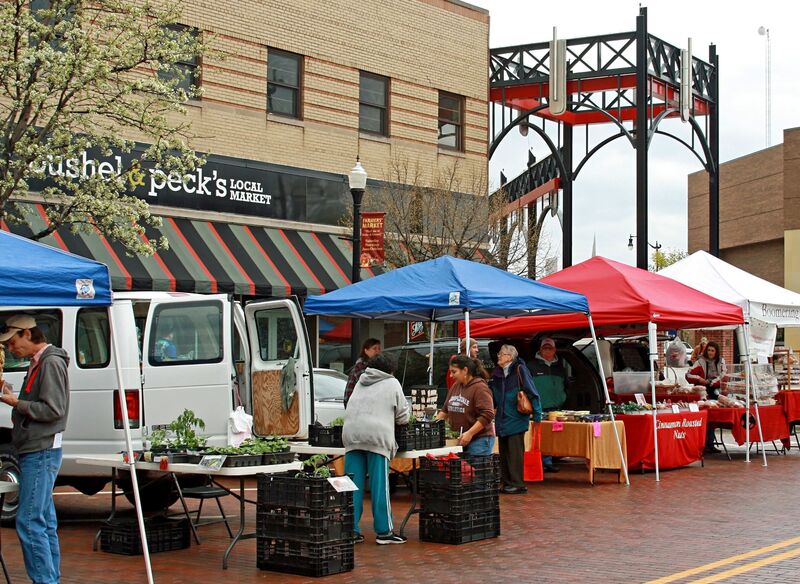Farmers’ markets provide many benefits for communities of all sizes. They offer a physical location for people to connect with their neighbors, access farm-fresh and healthy foods, and learn more about how food is grown. In addition, farmers' markets help generate economic activity at local businesses and may attract tourists looking for a special "taste of place." Perhaps most importantly, farmers' markets provide an opportunity for small and medium-sized farms to reach consumers directly and retain a larger share of profit from their products' sales.
Around the nation, farmers' markets are on the rise. The U.S. Department of Agriculture reports that the national total of farmers' markets doubled from 4,385 in 2006 to more than 8,669 in 2016. Wisconsin has kept pace with this nationwide trend, hosting approximately 265 markets in 2017, according to Kristin Krokowski, director of the Wisconsin Farmers Market Association and an educator with University of Wisconsin-Extension Waukesha County.

However, many of these markets fail within their first four years in business. While the number of farmers' markets has swelled, inexperienced management, high manager turnover, small size and low resources can make a market more susceptible to collapse.
Farmers' markets are also facing increased competition with a growing number of local food outlets, including community supported agriculture shares, grocery stores and online marketplaces. Moreover, the growing number of farmers' markets give consumers many options for shopping for locally grown products. Small, new and under-resourced markets may struggle to stay in operation in this crowded field.
Limited time, meager or non-existent budgets for marketing and a lack of formal training in marketing can further complicate the job of managing a farmers' market, but creative promotion and careful planning can help draw potential customers, grow a base of support and survive stiff competition.
Helping markets succeed
In 2017, a team of researchers at UW-Madison and UW-Extension surveyed market managers from around Wisconsin and compiled their findings in a report titled "Plan, Partner, and Promote: Best Marketing Practices from Wisconsin’s Farmers Market." It details how they have successfully navigated challenges and achieved long-term stability.
The surveyed market managers recommended new and struggling markets begin by creating a detailed plan for promotion and outreach. Growing a social media following and otherwise developing a digital presence through resources like websites and email newsletters are among their suggestions, but some market managers also utilize a more traditional word-of-mouth approach by reaching out to community organizations like nonprofits, churches, food pantries, schools and local associations to disseminate information.
Businesses and organizations within communities often engage in valuable partnerships with their local markets through in-kind donations, promotion or other support. In DeForest, for example, a local credit union helped the community farmers' market purchase card readers that allowed them to accept and process credit, debit and EBT payments. In exchange, the market manager mentions the credit union on social media and permits the distribution of branded shopping bags during the market.
Other engagement tactics, like market-wide giveaways that offer a prize basket with items from vendors or partnering organizations can help to raise a farmers' market's profile. By giving visitors something to discuss, markets can increase buzz among friends and family, swelling attendance numbers.
Managers of successful markets also cited clarity, uniformity and pleasing design in market and vendor signage as a feature that can help a market appear more organized and alluring to potential customers. Displays that detail the origin, growing practices or production techniques of products can appeal to patrons seeking local or organic goods and help to convey the vendors’ stories.
Finally, evaluation can be essential to the success of a burgeoning farmers' market. Once attainable goals are set, the manager can study how customer counts, surveys and sales data change over time to understand how outreach efforts have improved the market’s continuing viability. More information on transforming a market from a growing concern to a going concern can be found in the report.
Marlie Wilson is a graduate of University of Wisconsin-Madison with a joint degree in Agroecology and Urban & Regional Planning. Bret Shaw is an environmental communication specialist at University of Wisconsin Cooperative Extension and an associate professor in the Department of Life Sciences Communication at UW-Madison. Laura Witzling is a Ph.D. graduate of the Department of Life Sciences Communication at UW-Madison. Alfonso Morales is a specialist at UW Cooperative Extension and associate professor in the Department of Planning and Landscape Architecture at UW-Madison.
Despite Growth In Numbers, Many Farmers' Markets Face Fierce Competition was originally published on WisContext which produced the article in a partnership between Wisconsin Public Radio, Wisconsin Public Television and Cooperative Extension.
Memberships
Steve is a member of LION Publishers , the Wisconsin Newspaper Association, the Menomonie Area Chamber of Commerce, the Online News Association, and the Local Media Consortium, and is active in Health Dunn Right.
He has been a computer guy most of his life but has published a political blog, a discussion website, and now Eye On Dunn County.




Add new comment